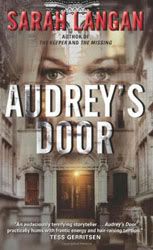| Pop Culture Gadabout | ||
|
Thursday, June 17, 2010 ( 6/17/2010 02:38:00 PM ) Bill S.  RED ANTS The title lead of Sarah Langan’s moody urban horror novel, Audrey’s Door, fits the mold of other isolated haunted heroines: thirtyish, coming out of a broken relationship with a rage-aholic boyfriend, the survivor of a childhood with a mentally ill mother, Audrey Lucas is just the sort of sensitive soul that a malevolent entity like the Breviary will try to trap. An elegant 19th century building located in a ritzy part of Manhattan, primarily inhabited by the cloistered offspring of the Gilded Age, the Breviary is the last surviving example of Chaotic Naturalism, an architectural design known for its embrace of structural chaos, making the building a spiritual cousin to Shirley Jackson’s Hill House in its brazen use of off-kilter angles. RED ANTS The title lead of Sarah Langan’s moody urban horror novel, Audrey’s Door, fits the mold of other isolated haunted heroines: thirtyish, coming out of a broken relationship with a rage-aholic boyfriend, the survivor of a childhood with a mentally ill mother, Audrey Lucas is just the sort of sensitive soul that a malevolent entity like the Breviary will try to trap. An elegant 19th century building located in a ritzy part of Manhattan, primarily inhabited by the cloistered offspring of the Gilded Age, the Breviary is the last surviving example of Chaotic Naturalism, an architectural design known for its embrace of structural chaos, making the building a spiritual cousin to Shirley Jackson’s Hill House in its brazen use of off-kilter angles.Architect Audrey is inevitably hooked by the place’s deliberately illogical construction (it is, we’re told the only example of Chaotic Naturalism not to have collapsed on its own over the years) even after she learns that the previous tenant of the apartment she’s considering killed her kids and slit her own wrists in the bathtub. As with most protagonists in haunting stories, Audrey is either foolishly ignoring the warnings of history or being driven by her own need to see how close to the edge she can skirt. It’s a little of both, we suspect. As in the best of these stories (the aforementioned Shirley Jackson work or Peter Straub’s Julia being good modern examples), Audrey’s Door works as both psychological and supernatural fright tale. We learn a lot about our heroine’s traumatic past with her scarifying diagnosable mother Betty through the book and are even provided a sequence where Audrey and her ex-bf travel to visit the now comatose mental patient in the hospital. Despite this, we also know for certain that something isn’t right about the Breviary from the get-go (a fact Langan establishes through regularly inserted newspaper and magazine stories from the building’s history) and that all the manifestations Audrey experiences -- the twisted dreams, the shredded belongings, the infestation of red ants (serving the same purpose as wasps do in The Shining), the voice that keeps entreating our heroine to “build the door” -- aren’t just figments of her mind. Something wants professional architect Audrey to build a door in the middle of her apartment, and we know that this can only be a Bad Thing. Audrey’s Door is at its most compelling when Langan keeps its focus on her high-strung heroine or her emotionally stunted boyfriend Saurab. It loses some steam when it shifts to Jill, Audrey’s Type A Boss, or any of the tenants of the Breviary, none of whom distinguish themselves as well as, say, the quirky geezerly Satanists who inhabited the building where Rosemary Woodhouse had her appalling pregnancy. If a few elements seem a bit too familiar -- soon as we meet the only other young tenant in the building we know that girl is toast because her primary role is to ratchet up the sense of impending doom -- it's not enough to spoil the fun. And while the specifics behind the workings of that sinister doorway are more than a little murky, we get enough to know our girl doesn’t want to see it finished and opened -- even if we do. Never before have the specifics of apartment renovation been so compellingly creepy. Labels: pulp fiction # | |
|
|

